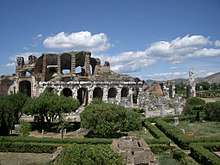Crypta Neapolitana
The Crypta Neapolitana (Latin; "Neapolitan crypt") (not to be confused with the Seiano cave or Grotta Seiano), is an ancient Roman road tunnel near Naples, Italy. It was built in 37 BC, and is over 700 metres long.

The tunnel connected Naples with the so-called Phlegrean Fields and the town of Pozzuoli along the road known as the via Domiziana.
Geography
The eastern entrance (on the Naples side) lies in the Vergiliano park of Piedigrotta ("at the foot of the grotta"); the western end is in the area now called Fuorigrotta ("outside the grotta").
The site is also noteworthy for the presence of the so-called Virgil's tomb, as well as the tomb of the Italian poet Giacomo Leopardi.
History
The first Roman road connecting Neapolis and the Phlegrean fields was built at the beginning of the 1st century BC and followed the easiest route but it was nevertheless still long, difficult, tortuous and traversed steep hills. It climbed the hills of Vomero and came back down towards Fuorigrotta arriving at the modern Via Terracina from where it continued to the ports of Puteoli and Cumae. As Puteoli and associated trade between the two cities grew, the old road needed to be improved.
The tunnel was first built by the architect Lucius Cocceius Auctus for Agrippa during the civil war between Octavian and Sextus Pompeius in c.37 BC.[1] The new road turned north at the west end of the tunnel, heading towards Via Leopardi and reconnecting with the old road, via Neapolis-Puteoli, at the top of Via Terracina where a way station (tabernae) and adjoining thermal spa complex has been excavated.
The tunnel is one of a number of such works in the area built by Cocceius such as the Grotta di Cocceio and Crypta Romana from Lake Avernus to Cumae as part of a network of military infrastructures including construction of the Portus Julius.
The tunnel was still in use as a roadway until superseded by two modern tunnels in the early 20th century, and shows extensive restoration done by the architects of the Bourbon dynasty of Naples. During the Second World War it was used as a bomb shelter for the inhabitants of Bagnoli; the war and some landslides during the fifties put it back into a state of neglect. Today it has been restored as an archaeological site.
According to mediaeval legend, the tunnel was built by the poet Virgil in a single night![2]
Notes and references
- Strabo , Geography , book V, chap. 4, par. 5
- Lancaster, Jordan (2005), In the Shadow of Vesuvius: A Cultural History of Naples, I.B.Tauris, p. 48, ISBN 1-85043-764-5, retrieved 2008-04-30
| Wikimedia Commons has media related to Crypta Neapolitana. |


